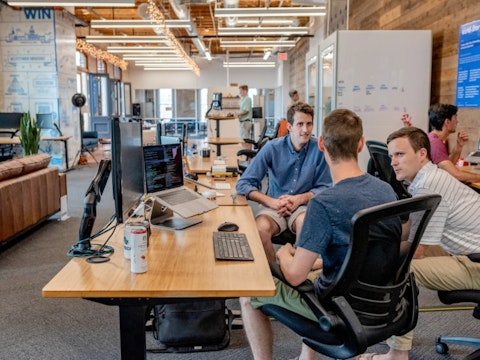Applied Blockchain, Inc. (NASDAQ:APLD) Q3 2023 Earnings Call Transcript April 6, 2023
Operator: Good morning, and welcome to Applied Digital’s Third Quarter €“ Third Fiscal Quarter 2023 Conference Call. My name is Melissa and I will be your operator today. Before the call, Applied Digital issued its financial results for the third quarter of fiscal 2023 ended February 28, 2023 in a press release, a copy of which will be furnished in a report on Form 8-K filed with the SEC and will be available on the Investor Relations section of the company’s website. Joining us on today’s call are Applied Digital’s Chairman and CEO, Wes Cummins; and CFO, David Rench. Following their remarks, we will open the call for questions. Before we begin, Alex Kovtun from Gateway Group will make a brief introductory statement. Mr. Kovtun, please go ahead.
Alex Kovtun: Thank you, operator. Good morning, everyone, and welcome to Applied Digital’s fiscal third quarter 2023 conference call. Before management begins their formal remarks, we would like to remind everyone that some statements we’re making today may be considered forward-looking statements under securities laws and involve a number of risks and uncertainties. As a result, we caution you that there are a number of factors, many of which are beyond our control, which could cause actual results and events to differ materially from those described in the forward-looking statements. For more detailed risks, uncertainties and assumptions relating to our forward-looking statements please see the disclosures in our earnings release and public filings made with the Securities and Exchange Commission.
We disclaim any obligation or undertaking to update forward-looking statements to reflect circumstances or events that occur after the date the forward-looking statements are made, except as required by law. We will also discuss non-GAAP financial metrics and encourage you to read our disclosures and the reconciliation tables to applicable GAAP measures in our earnings release carefully as you consider these metrics. We refer you to our filings with the Securities and Exchange Commission for detailed disclosures and descriptions of our business, as well as uncertainties and other variable circumstances, including but not limited to risks and uncertainties identified under the caption €œRisk Factors€ and our annual report on Form 10-K. You may get Applied Digital’s Securities and Exchange Commission filings for free by visiting the SEC website at www.sec.gov.
I would like to remind everyone that this call is being recorded and will be made available for replay via a link available in the Investor Relations section of Applied Digital’s website. Now, I will turn the call over to Applied Digital’s Chairman and CEO, Wes Cummins. Wes?
Wes Cummins: Thanks, Alex, and good morning everyone. Thank you for joining us for our fiscal third quarter 2023 conference call. I want to start by thanking our employees for their ongoing hard work including our construction and operations team for getting through the winter and keeping our facilities operational and construction timeline reasonable. Before turning the call over to our CFO, David Rench for a detailed review of our financial results, I’d like to touch on some updates from our business over the last quarter and why we remain excited about the future and in our ability to deliver long-term high margin sustainable cash flow. Let’s start with an update on our two newest facilities, Ellendale and Garden City. We successfully completed energization of our 180 megawatt facility in Ellendale, North Dakota in early March.
This marks the second facility that we energized within North Dakota following the successful 100 megawatt facility in Jamestown that was energized in 2022. Recall that we broke ground on Ellendale in September, €˜22 and are now powering and operating the new site only six months after initial work began. This is a tremendous accomplishment given the harsh winter weather we experienced in North Dakota over the last several months along with some construction delays. We continue to ramp up our capacity and anticipate this first half of capacity will be turned on by the end of April and the rest to be turned on by the end of June. The facility is fully contracted by Marathon for five years with a flat rate agreement and our agreement begins upon energization.
Once fully energized, this location will bring Applied Digital to 280 megawatts of hosting capacity across all €“ our facilities in North Dakota, all of which are contracted out to customers on multi-year terms. In addition to Ellendale, we’re making great progress on our 200 megawatt Garden City facility in Texas. The construction of Garden City is complete and over 130 megawatts of miners are installed and ready to turn on. Our customers are continuing to send miners to the facility and we’re actively installing them. Given the unique behind the meter aspect of this facility, we’re awaiting final approval on some final technical details and expect to resolve these issues in the coming weeks to begin energizing the facility. Once we energize our Garden City facility, we anticipated ramping faster than our Ellendale facility due to the amount of miners already installed.
As a reminder, both our Ellendale and Garden City facilities are fully contracted with fixed prices and we are not exposed any volatility in the cryptocurrency markets. Our 100 megawatt Jamestown facility continues to perform as expected and operated at full capacity throughout the quarter as we delivered revenue of $14.1 million in the quarter exceeding the $12 million steady-state capabilities of the facility that we previously discussed. As mentioned on our last call, we successfully retrofitted a small portion of our existing facility in Jamestown to accommodate HPC requirements to support a web three application with a non-crypto customer. We have decided rather than to use the GPU capacity for the web three application, it would be better used for machine learning and AI applications and have onboarded multiple customers and recognized our first HPC revenue in the quarter.
We also broke ground on a 5-megawatt standalone facility adjacent or Jamestown site in December that will host several hundred graphics processing units for machine learning application with a new customer. Our first GPUs in the new facility are expected to be operational later this month or early May. The build-out will be completed in two additional stages with the first scheduled to come online this summer, and the second later in the year. When finalized, we expect to have over 7,000 NVIDIA A100 class GPUs in the building, making it one of the largest GPU clusters of its kind in the world. Importantly, it’s worth noting that demand for hosting capacity across our facilities has not been impacted during the last several months and we’re exploring numerous opportunities.
Now let’s discuss the HPC opportunity in front of us and why we’re excited about the year ahead. While we continue to see robust demand from cryptocurrency miners, we aim to diversify our customer base and exposure to the growing segments of the HPC market, as we believe that will be the highest return of capital in the long-term for our shareholders. Our goal remains to get at least 10% of our revenue from HPC by the end of this calendar year and ultimately diversify our revenue to a 50/50 split by 2025. We remain optimistic about the growth opportunities in HPC, while which is expected to reach 900 billion globally by 2030 and remain well positioned to capitalize on this opportunity. As data continues to grow at an exponential rate, more data sources will required – will be required to store the data and we believe our next-generation facilities are ideal hosting sites for HPC applications as they can accommodate the unique demands for this growing industry.
Our data centers offer a more purpose-built solution offering, lower costs, combined with higher computing power compared to traditional data centers that are typically focused on delivering low latency and high computing power. We are well positioned for success in this space, given our expertise in hosting Bitcoin mining and realize the HPC applications require a different type of engineering that more resembles what you would see in an ASIC world at Bitcoin mining because of its dense power. The density of racks is a key point as each HPC applications require a different set up that provides sufficient power and cooling to handle those unique needs and properly scale efficiently. These applications don’t require ultra-low latency and so we believe that the deciding factor on whether these applications will be hosted comes down to the cost of compute.
Our next-generation data centers are optimized for green computing, and we aim to be the lowest cost compute provider, which are access to renewable energy and air cooling. To close, we remain confident that Applied Digital will continue to be a leader in digital infrastructure with our next-generation data centers. Demand for our services from both traditional customers and emerging HPC applications remains robust, which validates our position as a financially strong and leading digital infrastructure provider to serve various hosting needs. With that update, I’ll pass it over to our CFO, David Rench for a financial update.

Photo by Austin Distel on Unsplash
David Rench: Thanks, Wes, and good morning everyone. Before I begin my remarks, I would like to note that like last quarter’s call, since we did not have operations in a year ago comparable period, we will not be providing any year-over-year comparisons. Revenues in the fiscal third quarter were $14.1 million, which were entirely attributable to our hosting operations. The Jamestown site operated at full capacity throughout Dakota. Cost of revenues in the fiscal third quarter were $10.5 million, consisting of $8.6 million of energy cost to generate our hosting revenues, $900,000 of depreciation and amortization expense and $1 million of personnel expense for employees directly working at our Jamestown hosting facility. Adjusted gross profit, a non-GAAP measure that excludes depreciation embedded in the cost of revenues and one-time, electricity charges was $4.4 million or 31% of revenue for the fiscal third quarter of 2023.
Operating expenses for the fiscal third quarter of 2023 were $10.5 million, which includes $4.5 million of stock-based compensation, $3.9 million in other selling general and administrative costs and $1.1 million in depreciation and amortization expenses. Net loss attributable to Applied Digital for the fiscal third quarter of 2023 was a loss of $7 million or a loss of $0.08 per basic and diluted share based on a weighted average share count during the quarter of approximately $94.1 million. Adjusted net loss attributable to Applied Digital for the fiscal third quarter of 2023 was a loss of $7 million or a loss of $0.08 per basic and diluted share, based on a weighted average share count during the quarter of approximately $94.1 million. Adjusted net loss attributable to Applied Digital, a non-GAAP measure for the fiscal third quarter of 2023 was a loss of $1.4 million, or a loss of $0.01 per basic and diluted share, based on a weighted average share count during the quarter of approximately $94.1 million.
Adjusted EBITDA, a non-GAAP measure for the fiscal third quarter of 2023 was $900,000. Lastly, on our balance sheet. We ended the fiscal third quarter of 2023 with $22.9 million in cash and cash, equivalents and $23.7 million in debt. During the third fiscal quarter of 2023, we received $11.7 million in net customer deposits and $32.3 million in net deferred revenue, which collectively amounted to a $44 million net cash inflow due to the structure of our commercial arrangements with our customers that incorporate upfront deposits and prepayments. In certain contracts, the prepayments were amortized back to the customers for the first year of their contract with no impact to revenue recognition, but the timing of cash flow with upfront cash to us is a major benefit for the company and that it helps with our CapEx funding needs as we build our data centers.
Our balance sheet remains strong and we have no exposure to Celsius Network, First Republic Bank, FTX, Signature Bank, Silicon Valley Bank, or Silver Gate Capital Corporation. Now turning to guidance. Similar to last quarter, we will not be providing explicit guidance for the fourth quarter, given the revenue materiality of our Garden City potentially coming online and the continued ramp of the Ellendale facility that should occur in the fiscal fourth quarter. Once those facilities are online, we will have nearly 500 megawatts of hosting capacity that we expect to put us in an annualized adjusted EBITDA run rate of approximately $100 million. That completes my financial summary. Now I’ll turn the call over to Wes for closing remarks.
Wes Cummins: Thank you, David. I want to add a little more detail around our expectations for the current quarter. While we expect Garden City to energize during the quarter, if we exclude it completely and look at our expected ramp of Ellendale, we expect to generate approximately $24 million of revenue and approximately $4 million of EBITDA. Before we get to Q&A, I’d like to quickly go over some key goals and initiatives for our company as we look to the future of Applied Digital. We remain focused on operating our Jamestown facility of high, efficiency and look forward to energizing our Garden City facility and continuing to make progress at our Ellendale facility in the near term. We will also continue to build out our non-crypto use cases to demonstrate the broad capabilities of our next-generation data center assets for HPC applications.
So while the crypto industry remains volatile, we are well positioned to capitalize on strong demand for both crypto and non-crypto customers for our services. I remain optimistic about our future and what thank all of our team members for their dedication and service to Applied Digital. With that operator, let’s open up the call for questions.
See also 15 Top Performing European Stocks So Far in 2023 and 12 Cheap Healthcare Stocks to Buy in 2023.
Q&A Session
Follow Applied Digital Corp.
Follow Applied Digital Corp.
Operator: Thank you. Our first question comes from the line of Lucas Pipes with B. Riley Securities. Please proceed with your question.
Lucas Pipes: Thank you very much operator and good morning everyone. Congrats on the progress at Ellendale and I do want to ask about Garden City. You mentioned an expectation that it could come online in the coming weeks. And I wondered if you could touch on the level of confidence on that for that statement and in terms of a faster pace of energization, which was also mentioned in the prepared remarks is the ability to quantify the cadence of the ramp once you have those final metering issues, resolved. Thank you very much.
Wes Cummins: Thanks, Lucas. This is Wes. Let me try to explain the specific issue, the primary issue that we’re dealing with. And it is an issue which was behind the meter installation we’re not unique right now in Texas and there is several large projects turning on or trying to turn on and I think we might be the only Bitcoin mining project of its kind. So there’s several other kind of projects that are turning on. The issue at the way they settle on metering and the visibility they want in to the power gen plus the grid energy and there’s an issue with double settlement or being double counted. There’s not – or that say there wasn’t really a framework for this in ERCOT and we’re dealing with it mostly in the Encore side from a metering perspective.
ERCOT had a meeting last week for they had a rule change that should solve this issue. So now it’s back in the hands of Encore. We think that issue is solved, but they typically seem to move very slow. So while it wouldn’t be, didn’t happen the next day, we expect some really meaningful progress on finalizing €“ there is – just my opinion, some very simple solutions for it, but it just had to go to through the process and it feels like the process is now largely complete with the rule change, with the ERCOT it should solve the issue with Encore, not just for us, but for several different people. And so, we expect this to move forward in the very near term. So, hopefully, that makes sense. As far as the pace of energizing, so recall Ellendale, this is, as we build, we’re energizing.
The buildings will go up much faster. Now, we had all the concrete poured. We’re finalizing the buildings. All of them get worked on in stages. But now it’s just turning on each building as it’s completed as the miners are racked and as they’re available to turn on. So that that’s much more like we did in Jamestown. But because, we originally expected Garden City to energize much earlier, the construction is complete, the large majority of the miners are already racked. So we’re not doing it in those types of stages as we’ve done in North Dakota. So, when we have the final approval, when we’re ready to turn on all of these buildings are ready to turn on, so you could see these come up in just a week or two. It still takes a little bit of effort on each building.
But they’re already in place and ready to go. That’s why we would expect that to ramp up significantly faster than we’re seeing in Ellendale over that we saw in Jamestown last year.
Lucas Pipes: That’s very helpful. I appreciate the color Wes. And for my second question, I do want to turn to HPC. And could you share some light on what an anchor agreement could look like terms of revenue, unit, economics, term duration? And then, what would be the capital – potential capital requirements for a large HPC kind of anchor tenant? Thank you very much.
Wes Cummins: Sure, sure. So, there’s a couple of different models that were exploring with HPC. So, there is a model where, the first ones that we’re running in our – and what we call the HPC class and it’s the retrofitted portion of one of the mining buildings. We own those GPUs. We rent the capacity out. I think we mentioned with that three customers live on those doing mostly machine learning, deep learning applications and it’s been it’s been going really well. If you recall we have a software partner that is helping us with that on the front end that loads onto the system. So that’s gone very well. As we move into the pilot phase of the new building, so it’ll be around 300 GPUs that will ramp up, those will also be owned by us.
And so, we have customers when customers that are booked for those GPUs as well. And then the rest of the building can go in one of two ways. So there’s a potential for us to do just co-location on those areas. And if you think about co-location, at good areas, we’ve gotten a kind of put a finer point on this a good way to think about this is on a per megawatt basis and I’m just comping that to what we do with Bitcoin mining, because that’s what we’ve done so far. You should expect more in the 10 to 12 times revenue versus per megawatt versus the Bitcoin hosting for the HPC applications and similar lift in EBITDA maybe even slightly higher, might be a little bit better margin on the EBITDA front from an HPC co-location. If we move forward with owning GPUs, if that is what we land with our customer, it’s significant step up again as far as revenue and EBITDA.
But if we own the GPUs in the entire facility and we booked those out and we’d only do that if we had the right style of customer to do that and a very large solid counterparty to do that, that building would generate well north of $100 million of revenue and upwards of $50 million or $60 million of EBITDA. So, we are still working through how €“ what the business model. I think it will be a little bit split there. But right now, we are fully funded on our balance sheet now. We saw where the quarter ended with cash. As of yesterday, the company had about $41 million of cash. So actually a significant step up but that was the debt facility that went in place post the close of the quarter on the Ellendale facility that boosted that, But we are fully funded to build the building and to put the GPUs that we plan to put inside the building currently and we’re working on financing, if we’re going to move forward with owning more of the GPUs. But I think when you think about a longer-term model here, you should really think about co-location model is what we’re chasing, and then blend it in with some GPU ownership when necessary.




